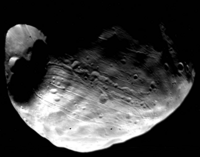Stickney crater

Stickney crater (at left)
(Viking orbiter, 10 June 1977). |
|
| Feature type | Impact crater |
|---|---|
| Location | 1°N 49°W / 1°N 49°WCoordinates: 1°N 49°W / 1°N 49°W |
| Dimensions | 9 km (5.6 mi) in diameter. |
| Discoverer | Asaph Hall |
| Naming | Chloe Angeline Stickney Hall |
Stickney is the largest crater on Phobos, which is a satellite of Mars. It is 9 km (5.6 mi) in diameter, taking up a substantial proportion of the moon's surface.
The crater is named after Chloe Angeline Stickney Hall, wife of Phobos's discoverer, Asaph Hall. In 1878 Hall wrote that he "might have abandoned the search [for Martian satellites] had it not been for the encouragement of [his] wife." The crater was named in 1973, based on Mariner 9 images, by an IAU nomenclature committee chaired by Carl Sagan.
Stickney has a smaller crater within it, about 2 km (1.2 mi) in diameter, resulting from a later impact. In 2006 it was given the name Limtoc, after a character in Gulliver's Travels.
Grooves and crater chains appear to radiate from Stickney. These have led to theories about the impact that formed Stickney nearly destroying the moon. However, evidence from the Mars Express orbiter indicate that they are unrelated to Stickney and may have been formed by material ejected from impacts on Mars. More recent modelling supports the theory that the grooves are signs of deformation caused by tidal forces. The crater has a noticeable lineated texture on its interior walls, caused by landslides from materials falling into the crater.
It is possible that Stickney is large enough to be seen with the naked eye from the surface of Mars. It is located at the middle of the western edge of the Mars-facing side of Phobos.
...
Wikipedia
